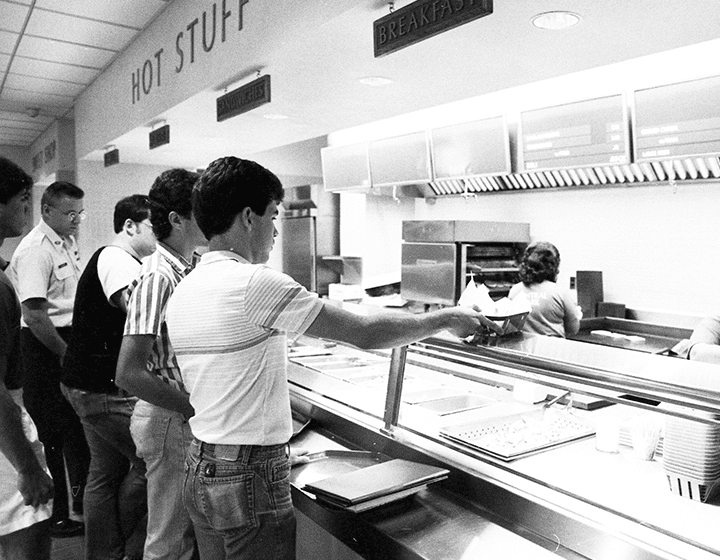
Students line up for meal service in the University Center cafeteria in 1986.
Hot Stuff
Students get more and more options for campus meals throughout the 1980s
[ This article was originally published in the UTSA newsletter The Roadrunner on October 24, 1988 ]
In nine years as director of food services at UTSA, Carol Schafer has seen the facility grow from a single cafeteria to a four-unit operation. In addition to operating the JPL cafeteria, the food service opened the Subway sandwich shop in 1982, the Central Park Cafeteria in the University Center in 1986 and the Activity Center Grill in 1987. The units serve between 6,000 and 7,000 people a day.
Schafer came to UTSA almost by accident. “I moved away from Texas in 1970, just after the Texas legislature had approved the bill appropriating an extension of the UT System,” she explains. “When I came back to San Antonio to visit my newborn granddaughter in 1979, nobody I asked knew anything about UTSA. I came to look it over, checked by the personnel office to see if there was anything available in residents’ dining and ended a week’s vacation with a job as director of food services. I have had a delightful association with the university ever since.”
The university food service now operates 275 hours each week, seven days a week, and as well as being responsible for feeding the masses, also prepares special campus-related lunches, dinners and banquets, presidential dinners and breakfasts for early morning meetings. “There always seems to be a crisis,” Schafer says, “so we all have to pitch in because people still want to be served.”
Schafer believes the “homecooked quality” of the food is the greatest advantage UTSA has over other university food services. “We continue to strive for the best food value per dollar anyone can get,” she says. “We try to please everyone, and I hear from a lot of people that our service is by far the best available.”
“People must realize, however,” she adds, “that we can either put their dollar into food or into replacing the flatwear that goes missing.” Schafer explains that the food service must order a thousand-dozen items each year to replace what people carelessly leave lying around campus or just plain steal.


